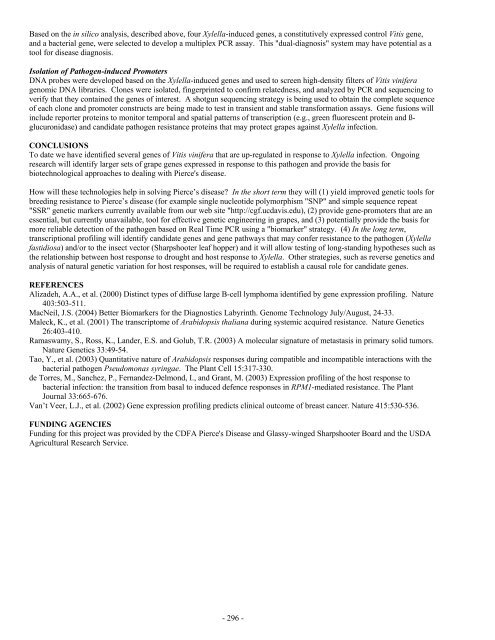Impact Of Host Plant Xylem Fluid On Xylella Fastidiosa Multiplication ...
Impact Of Host Plant Xylem Fluid On Xylella Fastidiosa Multiplication ...
Impact Of Host Plant Xylem Fluid On Xylella Fastidiosa Multiplication ...
Create successful ePaper yourself
Turn your PDF publications into a flip-book with our unique Google optimized e-Paper software.
Based on the in silico analysis, described above, four <strong>Xylella</strong>-induced genes, a constitutively expressed control Vitis gene,<br />
and a bacterial gene, were selected to develop a multiplex PCR assay. This "dual-diagnosis" system may have potential as a<br />
tool for disease diagnosis.<br />
Isolation of Pathogen-induced Promoters<br />
DNA probes were developed based on the <strong>Xylella</strong>-induced genes and used to screen high-density filters of Vitis vinifera<br />
genomic DNA libraries. Clones were isolated, fingerprinted to confirm relatedness, and analyzed by PCR and sequencing to<br />
verify that they contained the genes of interest. A shotgun sequencing strategy is being used to obtain the complete sequence<br />
of each clone and promoter constructs are being made to test in transient and stable transformation assays. Gene fusions will<br />
include reporter proteins to monitor temporal and spatial patterns of transcription (e.g., green fluorescent protein and ß-<br />
glucuronidase) and candidate pathogen resistance proteins that may protect grapes against <strong>Xylella</strong> infection.<br />
CONCLUSIONS<br />
To date we have identified several genes of Vitis vinifera that are up-regulated in response to <strong>Xylella</strong> infection. <strong>On</strong>going<br />
research will identify larger sets of grape genes expressed in response to this pathogen and provide the basis for<br />
biotechnological approaches to dealing with Pierce's disease.<br />
How will these technologies help in solving Pierce’s disease? In the short term they will (1) yield improved genetic tools for<br />
breeding resistance to Pierce’s disease (for example single nucleotide polymorphism "SNP" and simple sequence repeat<br />
"SSR" genetic markers currently available from our web site "http://cgf.ucdavis.edu), (2) provide gene-promoters that are an<br />
essential, but currently unavailable, tool for effective genetic engineering in grapes, and (3) potentially provide the basis for<br />
more reliable detection of the pathogen based on Real Time PCR using a "biomarker" strategy. (4) In the long term,<br />
transcriptional profiling will identify candidate genes and gene pathways that may confer resistance to the pathogen (<strong>Xylella</strong><br />
fastidiosa) and/or to the insect vector (Sharpshooter leaf hopper) and it will allow testing of long-standing hypotheses such as<br />
the relationship between host response to drought and host response to <strong>Xylella</strong>. Other strategies, such as reverse genetics and<br />
analysis of natural genetic variation for host responses, will be required to establish a causal role for candidate genes.<br />
REFERENCES<br />
Alizadeh, A.A., et al. (2000) Distinct types of diffuse large B-cell lymphoma identified by gene expression profiling. Nature<br />
403:503-511.<br />
MacNeil, J.S. (2004) Better Biomarkers for the Diagnostics Labyrinth. Genome Technology July/August, 24-33.<br />
Maleck, K., et al. (2001) The transcriptome of Arabidopsis thaliana during systemic acquired resistance. Nature Genetics<br />
26:403-410.<br />
Ramaswamy, S., Ross, K., Lander, E.S. and Golub, T.R. (2003) A molecular signature of metastasis in primary solid tumors.<br />
Nature Genetics 33:49-54.<br />
Tao, Y., et al. (2003) Quantitative nature of Arabidopsis responses during compatible and incompatible interactions with the<br />
bacterial pathogen Pseudomonas syringae. The <strong>Plant</strong> Cell 15:317-330.<br />
de Torres, M., Sanchez, P., Fernandez-Delmond, I., and Grant, M. (2003) Expression profiling of the host response to<br />
bacterial infection: the transition from basal to induced defence responses in RPM1-mediated resistance. The <strong>Plant</strong><br />
Journal 33:665-676.<br />
Van’t Veer, L.J., et al. (2002) Gene expression profiling predicts clinical outcome of breast cancer. Nature 415:530-536.<br />
FUNDING AGENCIES<br />
Funding for this project was provided by the CDFA Pierce's Disease and Glassy-winged Sharpshooter Board and the USDA<br />
Agricultural Research Service.<br />
- 296 -











